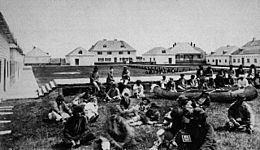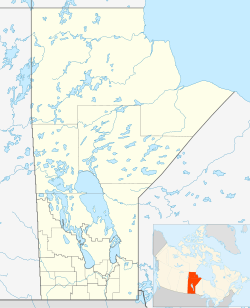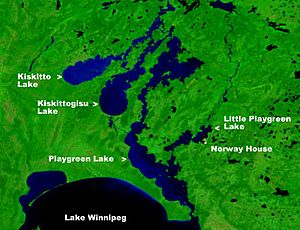Norway House facts for kids
Quick facts for kids
Norway House
|
|
|---|---|

Inside the fort at Norway House, NWT 1878
|
|
| Country | Canada |
| Province | Manitoba |
| Census division | 22 |
| Region | Northern Region |
| Time zone | UTC−6 (CST) |
| • Summer (DST) | UTC−5 (CDT) |
| Website | Norway House Cree Nation Norway House |
| Official name: Norway House National Historic Site of Canada | |
| Designated: | 1932 |
Norway House is a community of over 5,000 people in Manitoba, Canada. It is located about 30 kilometers (19 miles) north of Lake Winnipeg, on the eastern part of the Nelson River. The name 'Norway House' refers to both the town and a nearby First Nation reserve called Norway House 17. This reserve belongs to the Norway House Cree Nation (Kinosao Sipi Cree Nation). This means Norway House has both a Chief (for the First Nation) and a Mayor (for the community).
The community is quite far from major cities. It is about 456 kilometers (283 miles) by air north of Winnipeg. It is also 208 kilometers (129 miles) by air east of The Pas and 190 kilometers (118 miles) by air south of Thompson. If you drive from Winnipeg, it's about 800 kilometers (497 miles). From Thompson, it's about 300 kilometers (186 miles). The main ways people make a living here include fishing, trapping, logging, and working in government services.
Norway House was a very important place for the Hudson's Bay Company for most of the 1800s. It was a major storage and supply center. From the 1830s, it was also where the leaders of the company's Northern Department held their important meetings.
Contents
History of Norway House

After Europeans arrived in North America, the Hayes River became a key route for exploring Canada. From 1670 to 1870, explorers, fur traders, and settlers used the Hayes River. It was an easier route, and they could find more food along the way.
In 1816, Lord Selkirk sent a group of Norwegians to the area. They were tasked with building a road from York Factory to Lake Winnipeg. They also built several supply posts. Some stories say Norwegians were sent in 1814 with reindeer. They wanted to try raising reindeer for food and for pulling sleighs in winter.
In 1817, they built the first Norway House at Mossy Point. This new post replaced an older one called Jack River. This happened during a time when the Hudson's Bay Company and the North West Company were competing. They later joined together in 1821.
In 1822, Governor Simpson traveled through Norway House in winter. He was on his way to Cumberland House. Simpson also passed through Norway House in 1824–25 on his way to the Columbia District. He found a faster route that went through Norway House. This route was then used by the York Factory Express brigades.
Around 1825 or 1826, a fire destroyed much of the Norway House post. In 1826, the company moved the post to its current location. This new spot on the East River (now called Jack River) was closer to good fishing areas. Fishing was important for feeding the people living there.
By 1830, Norway House became more important than Cumberland House. From the 1830s, the yearly meetings of the Hudson's Bay Company leaders were held at Norway House. These meetings were where they planned for the next year. They also decided on promotions for their employees.
The last big meeting of the Northern Council happened at Norway House in July 1870. Donald Smith led this meeting. He had just helped with talks about the Red River Rebellion. The leaders met to discuss their rights regarding the transfer of Rupert's Land.
The old Hudson's Bay Company fort, built in 1825, is now a National Historic Site of Canada. It was named a historic site in 1932. This fort was the main inland supply center for the fur trade. It was also where Treaty 5 was signed in 1875. Some buildings from the fort still stand today. These include the Archway Warehouse (built 1839-1841), the Gaol (built 1855-1856), and the Powder Magazine (built 1837-1838).
Population and Communities
In the 2021 Census, the community of Norway House had 363 people. These people lived in 134 homes. This was a decrease from 478 people in 2016. The land area is 114.53 square kilometers (44.22 square miles).
The nearby community of Norway House 17 had a population of 5,390 people in 2021. This was an increase of 12.1% since 2016. This community has 2,239 homes and covers 72.99 square kilometers (28.18 square miles).
When you combine these two communities, Norway House is a population center of 5,753 people.
Getting Around Norway House
Provincial Road (PR) 373 is a road that can be used in all weather. It leads from Norway House past PR 374, which goes to Cross Lake. The road then goes through Jenpeg and connects to Provincial Trunk Highway 6.
There is a ferry that carries vehicles across the Nelson Channel, just north of Norway House. This ferry runs for most of the year. In winter, when the water freezes, an ice bridge opens for cars to cross. Sometimes, the ferry can get stuck when the water starts to freeze, causing delays.
For this remote area, the most important way to travel is by airplane. Manitoba Northern Airports manages Norway House Airport. It has a crushed-rock airstrip that is 1,189 meters (3,901 feet) long. There are daily flights to Winnipeg with Perimeter Aviation.
Local Services
Norway House has many useful services for its residents. You can find several restaurants and two hotels here. There is also a Royal Bank branch. For shopping, there are two Northern stores. If you're looking for a quick bite, there are two Tim Hortons and a KFC. The community also has a full-service post office and paved roads.
The community is kept safe by the Royal Canadian Mounted Police (RCMP). There are also NHCN Safety Officers who help keep the peace.
Education Opportunities
The Helen Betty Osborne Ininiw Education Resource Centre is a school for students from kindergarten to Grade 12. It also has a preschool program. This school is one of the most modern in the province. It is also one of the biggest schools in the Frontier School Division.
Norway House is also home to a regional center of the University College of the North. Students can also take university courses here. These courses are offered through satellite programs from Brandon University and the University of Manitoba.
Climate and Weather
Norway House has a subarctic climate. This means it has long, cold winters and short, cool summers. Like most of Manitoba, it gets most of its rain in the summer. Winters are usually very cold and dry. Norway House holds the record for Manitoba's coldest temperature. On January 9, 1899, the temperature dropped to -52.8°C (-63°F).
| Climate data for Norway House (1981–2010 normals & extremes until 2010) | |||||||||||||
|---|---|---|---|---|---|---|---|---|---|---|---|---|---|
| Month | Jan | Feb | Mar | Apr | May | Jun | Jul | Aug | Sep | Oct | Nov | Dec | Year |
| Record high °C (°F) | 7.7 (45.9) |
9.0 (48.2) |
14.0 (57.2) |
25.9 (78.6) |
33.0 (91.4) |
33.8 (92.8) |
34.7 (94.5) |
32.2 (90.0) |
31.1 (88.0) |
22.9 (73.2) |
12.8 (55.0) |
5.4 (41.7) |
34.7 (94.5) |
| Mean daily maximum °C (°F) | −16.1 (3.0) |
−11.4 (11.5) |
−3.8 (25.2) |
5.9 (42.6) |
14.1 (57.4) |
20.1 (68.2) |
23.3 (73.9) |
22.0 (71.6) |
14.8 (58.6) |
6.0 (42.8) |
−4.7 (23.5) |
−13.2 (8.2) |
4.7 (40.5) |
| Daily mean °C (°F) | −21.5 (−6.7) |
−17.6 (0.3) |
−10.3 (13.5) |
−0.2 (31.6) |
7.9 (46.2) |
14.1 (57.4) |
17.6 (63.7) |
16.5 (61.7) |
9.7 (49.5) |
2.0 (35.6) |
−8.8 (16.2) |
−18.2 (−0.8) |
−0.7 (30.7) |
| Mean daily minimum °C (°F) | −26.9 (−16.4) |
−23.7 (−10.7) |
−16.9 (1.6) |
−6.2 (20.8) |
1.7 (35.1) |
8.1 (46.6) |
11.9 (53.4) |
10.9 (51.6) |
4.7 (40.5) |
−2.1 (28.2) |
−12.9 (8.8) |
−23.2 (−9.8) |
−6.2 (20.8) |
| Record low °C (°F) | −52.8 (−63.0) |
−45.6 (−50.1) |
−41.5 (−42.7) |
−32.7 (−26.9) |
−12.0 (10.4) |
−2.0 (28.4) |
1.8 (35.2) |
−1.4 (29.5) |
−7.0 (19.4) |
−22.8 (−9.0) |
−35.9 (−32.6) |
−45.0 (−49.0) |
−52.8 (−63.0) |
| Average precipitation mm (inches) | 17.6 (0.69) |
16.7 (0.66) |
20.3 (0.80) |
20.9 (0.82) |
41 (1.6) |
63.8 (2.51) |
77.5 (3.05) |
73.3 (2.89) |
51.5 (2.03) |
39.5 (1.56) |
25 (1.0) |
22.9 (0.90) |
469.9 (18.50) |
| Average snowfall cm (inches) | 26.5 (10.4) |
28.7 (11.3) |
26.5 (10.4) |
17.8 (7.0) |
5.9 (2.3) |
0.1 (0.0) |
0.0 (0.0) |
0.0 (0.0) |
1.5 (0.6) |
21.4 (8.4) |
33.1 (13.0) |
33.6 (13.2) |
195.1 (76.6) |
| Average precipitation days | 14.5 | 12.2 | 10.9 | 8.1 | 11.0 | 12.0 | 13.4 | 12.8 | 12.6 | 13.3 | 14.5 | 14.2 | 149.5 |
| Source: Environment Canada | |||||||||||||
Treaty and York Boat Days
Every summer, Norway House celebrates Treaty and York Boat Days. This event happens for a week starting in early August. The main attraction is the York Boat races. Teams of young people aged 8–18 compete in these boat races. This event honors the traditions of their ancestors. They used York Boats for transportation long ago.
During Treaty and York Boat Days, different groups host food booths. The community comes together to enjoy homemade meals. It's a time for celebration and remembering history.




